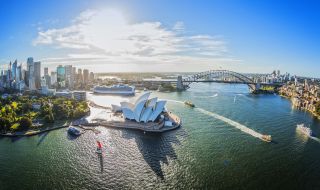

Blue Mountains National Park
The Three Sisters, Blue Mountains



There are rock formations, then there’s the Three Sisters, arguably the most recognised attraction in the Blue Mountains National Park. But this immense swathe of protected parkland also incorporates many other spectacular landmarks, with endless opportunities for exploration and immersion into nature. Enjoy exhilarating walks, discover Aboriginal history, hike to tumbling waterfalls and enjoy picnics in parks with stunning, far-reaching vistas of ancient escarpments and forest-clad valleys.
Begin your exploration of the Blue Mountains National Park at the Heritage Centre at Blackheath. Run by the National Parks and Wildlife Service, this base delivers a wealth of information about the area. Here, you will find maps, information, local history and art displays; and if you’re heading off on a long hike, you should register your intentions here so someone knows where you’re going. Don't miss the enlightening Outside In exhibit, which reveals the landscapes of the Grose Valley through Aboriginal eyes.
Read more: 5 fun family-friendly activities in the Blue Mountains

Blue Mountains Heritage Centre, Blackheath
Steeped with ancient folklore and legend and rich with important cultural sites, the Greater Blue Mountains World Heritage Area was the traditional homelands of six groups of Indigenous people – Darug, Gundungurra, Wiradjuri, Wanaruah, Darkinjung and Tharawal. Exploring this vast and sacred Country with local Aboriginal guides not only provides an insight into the world’s oldest living culture, but also reveals ancient secrets about connection to the land and how to care for it.
Discover an art gallery layered with handprints and stencil, thought to have been painted between 500 and 1,600 year ago at Red Hands Cave in Glenbrook; while nearby at Campfire Creek, marvel at axe-grinding grooves on the water’s edge.

Red Hands Cave - Credit: NSW National Parks and Wildlife Service
The Lyrebird Dell Walking Track from Leura leads through spectacular gorges to a huge sandstone cave, which was used as an Aboriginal shelter dating back more than 12,000 years. Walls Cave in Blackheath was another important shelter, which can be visited on a guided tour with an Aboriginal ranger from National Parks & Wildlife Service.
The Aboriginal Blue Mountains Walkabout is an immersion in Indigenous culture. Winding through a beautiful and secluded rainforest gully, along the trail of an original Songline, this full-day tour is a moving and inspirational experience that includes body painting, bush food and storytelling.
At Echo Point, take a close look at the Gathering Place, built in consultation with Darug and Gundungurra elders. Used as a stage for cultural presentations, the amphitheatre overlooking the Three Sisters is etched with a ‘Map of Country’ representing the waterways in the region; while LED lights mirror four constellations in the night sky.
Read more: The most stunning waterfalls & swimming holes in the Blue Mountains

Three Sisters, Katoomba
Lookouts offering incredible views of the Blue Mountains' natural wonders are dotted all over the park. In Katoomba, the spectacular Narrow Neck Lookout overlooks Narrow Neck Peninsula – a popular area among mountain bikers. Nearby, Scenic World offers multiple breathtaking ways to view the surrounding scenery with a Scenic Skyway across the gorge, the world’s steepest railway; the Scenic Railway that descends into the valley; and Scenic Walkway through the rainforest. There’s also Beyond Skyway, a cable car suspended 270 metres above the valley. Vistas don’t get more jaw-dropping than this.

Sydney Adventure Tours, Katoomba
In Blackheath, Govetts Leap Lookout and Evans Lookout offer some of the most popular and photographed views in the park, along with the Wentworth Falls Lookout in Wentworth Falls and Gordon Falls Lookout in Leura.
Read more: The most stunning scenic lookouts in the Blue Mountains

Wentworth Falls, Blue Mountains
The Blue Mountains National Park is also famous for thrilling adventure sports. Blue Mountains Adventure Company and High and Wild Australian Adventures run regular tours for rock climbing, abseiling and canyoning across some of the mountains’ most famous peaks. There are options for absolute beginners and experienced climbers.

Blue Mountains Adventure Company, Blue Mountains - Credit: David Hill
There are hundreds of walking trails threaded throughout more than 2,500 square kilometres of untouched bushland in the Blue Mountains National Park. The Grand Canyon Track, first opened in 1907, is one of the most famous and takes in dramatic waterfalls, bubbling creeks and soaring lookouts. The Cliff Top Walking Track runs between Govetts Leap and Evans Lookout, offering sweeping views over the Grose Valley. Or follow the Valley of the Waters trail to explore beautiful waterfalls and swimming holes.

Grand Canyon Walking Track, Blackheath
Horseriding adventures are also popular, with many trails through stunning wilderness. Centennial Glen Stables offers guided trail rides through the magnificent Kanimbla Valley; Megalong Valley Farm runs rugged wilderness rides along the Coxs River; and in Oberon, you can explore a working farm on horseback with High Country Trail Rides.
Read more: 9 of the ultimate outdoor adventures in the Blue Mountains
Stay connected to Visit NSW for all the latest news, stories, upcoming events and travel inspiration.
All the insider news, tips and inspiration you need to plan your next trip, delivered straight to your inbox.
Sign UpVisitNSW.com is the official tourism site for Destination NSW.
© Copyright 2025 Destination NSW. All rights reserved